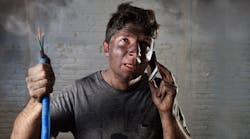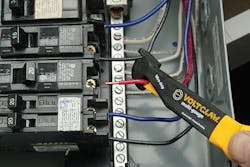Hurricanes Irma and Harvey have left trails of devastation throughout Texas, Florida and many Southeastern states, bringing heavy rains, storm surges and flash flooding. Now, as evacuated residents are beginning to return to their houses, repairing and restoring electrical systems is paramount to getting their lives back to normal.
"If a house has flooded, an electrical system should be thoroughly checked and repaired by a professional electrician," says Warren Tarbell, president of the Nonconductive Tool Company, the maker of Voltclaw nonconductive pliers. "However, homeowners with a background in electrical work can perform minor repairs if they follow important safety steps."
Follow these steps to reduce the likelihood of shock. (And if you've never worked with electrical gear before, now is not the time to start; skip to #7.)
- Disconnect the main electrical breaker. If the main switch is located in the basement, be sure all flood water has been pumped out before working on the electrical system. Water conducts electricity and live power lines can be deadly, especially if they are submerged or not easily visible.
- Remove covers from switches, outlets and other electrical connections. Double check with voltmeter or non-contact voltage detector to make sure the electricity is turned off. Next, pull receptacles, switches and wires about 2 inches out from their boxes without disconnecting the wires. Clean out mud and dirt with clean water and allow wires and connections to dry.
- Check the system for electrical shorts. Close the main switch and look for sparks or smoking wires which indicate shorted switch connections. If you see evidence of such shorts, you need a new switch.
- For 24-48 hours be careful when using receptacles and switches. There may be residual moisture which could cause shocks.
- If some of the circuits are faulty, use only the undamaged circuits. However, do not overload undamaged circuits with too many lights or appliances until normal capacity is restored.
- Newer homes have ground fault circuit interruptions with their circuit breaker. GFCIs will need to be replaced.
- Call a professional electrician if you need assistance on how to complete these electrical tasks.
The Importance of Insulation
Wear rubber gloves and rubber-soled boots for all work with electrical circuits in a wet environment. Rubber is an insulator and will help protect from electrocution. Standing on a dry wooden board is also good practice.
Insulated, non-conductive tools are the safest choice. For example, Voltclaw pliers are non-conductive to 1000V making the tools a far safer alternative to metal screwdrivers or wire strippers when grabbing, pulling, pushing and bending of electrical wires. With no metal parts, the tool will also not cut or scrap the insulation off of wires which can create a potential electrocution or fire hazard.



